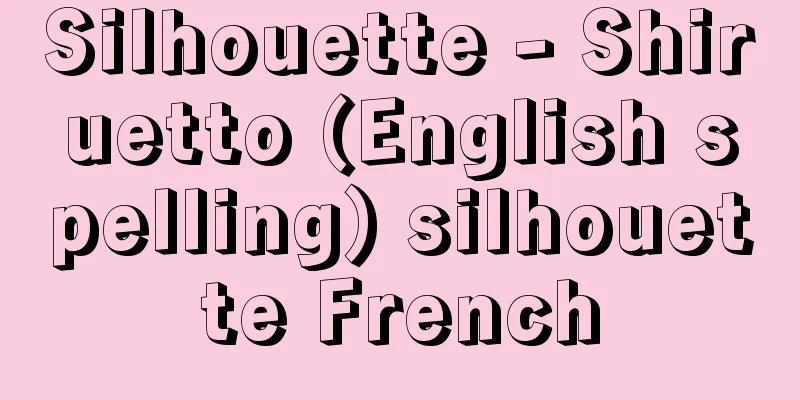Silhouette - Shiruetto (English spelling) silhouette French

|
A monochrome image with the inside of the outline filled in. Shadow puppets. In a broader sense, similar images can be found in Paleolithic cave paintings and Greek and Etruscan vase paintings, but the etymology of the word comes from the fact that Étienne de Silhouette (1709-67), the Minister of Finance of 18th century France, who implemented austerity policies, liked cut-out profile portraits, or silhouettes in the narrow sense, and created them himself as a hobby. At the time, "silhouette" is said to have had the connotation of "cheap." From the mid-18th century to the mid-19th century, these simple and inexpensive shadow puppets became popular throughout Europe. The British painter John Myers was famous as a specialist painter, and it is said that the great writer Goethe was also a fan. However, it fell into decline with the advent of photography. [Oi Kenchi] As a clothing term, it generally refers to the outline of the garment, which expresses its shape and overall tone when worn, and also describes the fashionable forms and designs of clothing. The silhouette is the physical appearance of the garment, and in order to create it most effectively, the fabric, structural and decorative elements, etc. are taken into consideration. Furthermore, underwear can play a major role in allowing the garment to be worn in a state that makes the most of the silhouette. Corsets used by women in the early modern period that unnaturally tightened the waist, as well as waist frames, waist guards, and padding that dramatically expanded the area below the hip line, were also used to emphasize the silhouette. Sometimes the garment itself was padded. There are many different silhouettes of clothing. Some scholars have tried to classify women's clothing, broadly categorizing them into straight, bell, and bustle shapes (American A. Young's theory), oval, square, triangular, and hourglass shapes (M. Fetherstone and Mark DH Maack's theory), tailored and draped shapes (G. Morton's theory), and flowing linear, full, boxy, T-shaped, chemise, and back-flared shapes (Hilhouse and Marion's theory). CW Cunnington, who also considered men's clothing, said that women's clothing is X-shaped and men's clothing is H-shaped. He said that all silhouettes can be captured by combining the relative changes in height and angle of the waist, with the intersection of the X-shape. If we talk about skirts alone, they can be divided into parachute-shaped bouffants (including farthingales, hoops, and crinolines), Gibson girl styles with trumpet-shaped hemlines, bustle styles that emphasize the hips at the back, and straight styles. For men's clothing that is H-shaped, the combination of a jacket and trousers is considered to be one type. The X-shaped silhouette of the top and bottom of women's clothing has changed over the years and is characteristic of each era, but based on its shape it can be classified into straight and curved types. Other silhouettes are based on the structural characteristics of the garment, such as the shirtwaist silhouette (a garment buttoned from the collar to the hem of the skirt), the draped silhouette (a garment with draping throughout), and the tiered silhouette (a garment with tiered decoration). [Yoshiko Tamura] “Fashion Dictionary” edited by Akira Ishiyama (1972, David Publishing) ▽ “Fashion Encyclopedia” edited by the Fashion Culture Association (1976, Bunka Publishing Bureau) ▽ “E. Nevill JacksonThe History of Silhouettes (1911, The Connoisseur, London)” ©Shogakukan "> Clothing silhouette (linear) ©Shogakukan "> Clothing silhouette (curved shapes) Source: Shogakukan Encyclopedia Nipponica About Encyclopedia Nipponica Information | Legend |
|
輪郭の内側を塗りつぶした単色画像。影絵。広義には旧石器時代の洞窟(どうくつ)画や、ギリシア、エトルリアの壺絵(つぼえ)にも同種の画像があるが、語源は、18世紀フランスで緊縮財政策をとった蔵相エティエンヌ・ド・シルエットÉtienne de Silhouette(1709―67)が、切絵による横顔の肖像画、狭義のシルエットを好み、自身でも趣味として制作したことによる。当時「シルエット」には「安上がり」の意が込められていたという。18世紀なかばから19世紀なかばにこの簡便で安価な影絵は全ヨーロッパ的に流行した。専門画家としてイギリスのジョン・マイアースJ. Miersが著名。また文豪ゲーテも愛好したといわれている。しかし写真術の出現により衰微した。 [大井健地] 服飾用語としては、一般には着装時の服の形や全体的調子を表す外郭線をさし、流行の服の形態やデザインを表すものでもある。シルエットは服装の身上(しんじょう)であり、これをもっとも効果的に創造するため、生地(きじ)、構成的・装飾的要素などが考慮される。さらにそれをよりよく生かした状態で着装できるよう、下着が大きな役割を果たすこともある。また、近世において女性が用いた、腰を不自然に締め付けるコルセットや、ヒップ・ライン以下を極端に膨らませるための腰枠、腰当て、詰め物などもシルエットを強調するためのものだった。服自体に詰め物をすることもある。 服装のシルエットは実に多種多様である。とくに女性の服装においては、何人かの学者がその分類を試み、それらを直線形、釣鐘形、それに腰当てを使ったバッスル形に(アメリカのヤングA. Youngの説)、あるいは楕円(だえん)形、四角形、三角形、砂時計形に(フェザーストンM. FetherstoneとマークD. H. Maackの説)、あるいはテーラード形、ドレープ形に(モートンG. Mortonの説)、また流動線形、ふっくら形、箱形、T形、シュミーズ形、バックフレア形に(ヒルハウスHilhouseとマリオンMarionの説)大別している。男子服をも含めてとらえたカニングトンC. W. Cunningtonは、婦人服はX字形、男子服はH字形だとしている。X字の交差する点をウエストとし、その高さ、角度の相対的変化のなかでの組合せによって、すべてのシルエットがとらえられるというものである。これをスカートだけについていえば、落下傘形のブファン(ファージンゲール、フープ、クリノリンなどが含まれる)、裾(すそ)がらっぱ状に膨らむギブソン・ガール形、これが背面のヒップで強調されたバッスル形、直線形とに分けられる。H字形とされた男子服は、上着とズボンとの組合せを一タイプとしてとらえられている。 X字型とした婦人服の上下のシルエットは各時代によって変化し、時代を特徴づけるものだが、その形から直線形、曲線形に分類できる。 このほかに、服の構成上の特徴からとらえたシルエットがある。シャツウエスト・シルエット(襟元からスカートの裾までボタン留めになった服の外形)、ドレープ・ド・シルエット(全体にドレープを取り入れた服の外形)、ティアー・シルエット(段々飾りのある服の外形)などがそれである。 [田村芳子] 『石山彰編『服飾辞典』(1972・ダヴィッド社)』▽『服装文化協会編『服飾大百科事典』(1976・文化出版局)』▽『E. Nevill JacksonThe History of Silhouettes(1911, The Connoisseur, London)』 ©Shogakukan"> 服装のシルエット(直線形に属するもの) ©Shogakukan"> 服装のシルエット(曲線形に属するもの) 出典 小学館 日本大百科全書(ニッポニカ)日本大百科全書(ニッポニカ)について 情報 | 凡例 |
Recommend
Residence inspection - Ikenchi
...In each domain, the feudal lords conducted the...
Anion exchange
...It has been noted for its ability to separate ...
Murdannia nudiflora (English spelling)
…[Tetsuichi Yahara]. … *Some of the terminology t...
Distillers Co., Ltd. (English name)
...Currently, there are 2,500 brands of Scotch wh...
Acocotlis
...The flower is a head of many tubular flowers w...
Veto - veto
The power of one organ of a national or local gov...
Vilde, E. (English spelling) VildeE
…Janssen’s daughter Koitula sang of patriotism in...
Amewakahiko
A god who appears in the Kojiki and Nihon Shoki. I...
Working conditions
It refers to all the conditions under which a wor...
Semipalatinsk
A city on the east bank of the Irtysh River in Kaz...
English: Yasdemodoki (Gibaraki) - Yasdemodoki
A general term for tiny myriapods belonging to the...
Fukuda [town] - Fukude
A former town in Iwata County facing the Enshu Nad...
Airflow dryer - Airflow dryer
The material is then picked up and dropped from t...
Giant oil bat - Great oil bat
...Its main natural enemy is the domestic cat. Th...
Infinite product
Also known as an infinite product. Let { a n } be ...





![Joyo [town] - Joyo](/upload/images/67cbe0da6e8b6.webp)



